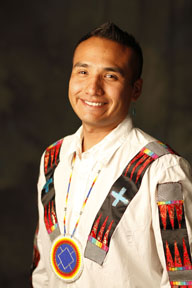In 2015, Travois is celebrating 20 years of service and a $1 billion impact in American Indian, Alaska Native and Native Hawaiian communities. We are proud of our clients’ and partners’ incredible achievements over the past 20 years, and we want to help shine a spotlight on all of the positive things that are happening in Indian Country and Native communities.
The American Indian College Fund (the College Fund) is also celebrating a big milestone — its 25th anniversary! Cheryl Crazy Bull (Sicangu Lakota), president and CEO of the College Fund, answered questions for us about what #20YearsEquals (actually, 25 years) to the College Fund in its mission to transform Indian higher education.
Ms. Crazy Bull, whose Lakota name Wacinyanpi Win means “they depend on her,” has more than 30 years of experience working in education for adults, higher education, and K-12 education with Native American institutions. She has been serving as the president and CEO of the College Fund since September 2012.
1. Why was the American Indian College Fund founded?
Tribal Colleges and Universities (TCUs) are nearly all located in rural environments where there is limited access to private sector funds whether from individuals, corporations or foundations. Visionary leaders of the Tribal College movement along with supporters established the College Fund to bring those who interested in supporting education or Native people together with students and Tribal Colleges. It is a considerable investment to bring private sector funds to support education, and it is more economical for the College Fund to do this on behalf of the TCUs instead of each college doing this individually.
2. Congratulations on your 25th anniversary! What has the College Fund accomplished in its first 25 years?
Our biggest accomplishment is that we have dramatically increased access to education by giving out nearly 100,000 scholarships. We know that our Native students probably wouldn’t go to college if not for the Tribal Colleges and that our support increases their success. We have also helped the Tribal Colleges build new campuses and add new academic and community programming making our colleges even more useful to the success and prosperity of students and of tribal nations.
3. For those who aren’t familiar with the term “Tribal College,” what is it? How are Tribal Colleges different than other schools?
Nearly all Tribal Colleges and Universities (also known as TCUs) are chartered by an Indian tribe through the authority of the tribe to operate its own education programs. Some TCUs have unique governance like Haskell Indian Nations University, which is a Bureau of Indian Education operated school, but most are chartered. TCUs are different in several ways but a few important distinctions are:
a. Curriculum content: TCU curriculum integrates Western knowledge with tribal knowledge with tribal knowledge having the most authority in terms of credibility and context.
b. Student body: The vast majority of TCU students are American Indian or Alaska Native so at Tribal Colleges, Native students go to school together.
c. Place-based: TCUs offer their educational services and programs in a manner that is derived from and honors the place that the TCU operates in. Native languages are taught, local tribal knowledge is integrated in the curriculum, and the local community provides cultural, experiential and economic context and support.
d. The governing boards of TCUs are Native people from the communities where the colleges are located.
4. What challenges do Tribal Colleges face that other schools do not have?
Having appropriate, culturally-responsive curriculum is a challenge because tribal knowledge is generally oral so curriculum materials needed to be developed; TCUs are overcoming extreme poverty and generations of oppressive government policies and practices; TCUs are very underfunded and often have to rely heavily on grants to support programs instead of having solid core operating support, and students are very underprepared and underfunded — more so than any other minority group in the country.
5. In general, what are common challenges that American Indian college students face more often than other students?
Some of the many challenges American Indian College students face when attempting to attend college include the following:
a. Lack of financial resources and assets to support going to college — 95 percent of our students needs financial support
b. Extreme poverty and its attendant characteristics — lack of adequate housing, transportation, health care — so many times our students struggle to meet their basic needs
c. Family experience with education has either been traumatic or is not a college-bound/college attendance experience — we have more first-generation college students than other groups
d. Responsibilities are often greater for AIAN students — they have children to support, perhaps have a job, have extended family responsibilities and because of the reservation environment, it often takes considerably more effort for students to get every business done. Even access to gas stations, laundromats and finding places to eat are limited for students.
6. Before the College Fund was founded, how many American Indians held college degrees? What is the percentage now, and how do you plan to create even greater numbers of American Indian graduates?
It is difficult to find good data about the retention and completion of American Indians and Alaska Natives in higher education as far back as 1990. We know the numbers are not large and that the creation of Tribal Colleges as a part of a broader systemic approach to American Indian and Alaska Native participation with higher education has made a significant impact across Indian Country. 2013 data from the U.S. Census identified over 338,000 Native people with associate degrees or higher. Tribal Colleges helped make this happen.
Our plan is to expand the number of scholarships, increase the scholarship annual award, and build more multi-year scholarship programs; increase access to career education, internships and research opportunities; support Tribal College program development that improves student retention such as scaling up best practices, implementing more extensive academic and personal counseling, and faculty development.
7. How does higher education help American Indians individuals and their communities?
Higher education especially when students participate within an educational environment that is culturally-responsive and place-based is very empowering — it honors and reinforces tribal identity, builds on kinship and community togetherness, supports economic, political and social engagement that creates social change and helps our tribal communities become more prosperous.
8. Is there a student success story that you will always remember that you can share with us?
All of our students are inspiring and amazing. Waylon Ballew (Lummi Tribe of the Lummi Reservation/Northern Cheyenne) is a good example of a Tribal College student success story. Waylon believes tradition is an important part of higher education. In order for him to be a community leader, Waylon said he must carry his traditions forward for future generations.

Growing up on Bellingham Bay in northwest Washington state, Waylon said he was immersed in community youth leadership programs, where he incorporated leadership training in community youth tribal canoe journeys as he traveled ancestral waterways to potlatches (gatherings).
“Sometimes it can take weeks to get to a destination by canoe. During this time we teach the young to use their newly acquired leadership skills. They ask permission to stay the night in another tribe’s territory, set up camp, and decide how the canoe will travel the next day. Because this is a traditional event, I love sharing and teaching the youth traditional values such as weaving, songs, dances, language, storytelling, and history. I hope sharing with these future leaders will encourage them to pass on to others what they have learned,” Waylon said.
Waylon leads at school as well. A member and past president of the Phi Theta Kappa’s Beta Iota Honor Society and a recipient of their Regional Pinnacle Award, he said he chose to study at Southwestern Polytechnic Institute (SIPI), one of 37 Tribal Colleges, because he believes tradition, history, and culture are important components of leadership.
At SIPI Waylon served as vice president of the school’s National Honor Society chapter. After earning his bachelor’s degree, he transferred to the University of New Mexico, where he is now a third-year student with a 3.90 grade point average working towards earning a bachelor’s degree in American Indian/Native American Studies. He plans to enter law school after graduation.
Waylon likens the scholarship support he receives from AT&T and the American Indian College Fund to the support crews in traditional Lummi canoe journeys that provide food, warmth, safety, and encouragement along a journey. “The support crew always remains within seeing distance of the canoe, waiting for a sign that would indicate the need for assistance. Scholarships provide me with that safety boat, that well-being. In the past, I have been unable to apply to school or afford my books due to lack of funds. When I began this journey, I came with the idea I was alone. I was determined to keep afloat. I obtained a full-time job, working graveyard shifts, which only allowed me 3-4 hours of sleep a day. Homework was a priority, and I made sure it was on time for class every time. Once, I awoke crying because I was so tired and had homework to do. Not long after, I applied to the American Indian College Fund for scholarships. These funds allowed me to resign from full-time work to focus on my studies…I shall not forget the opportunities given to me in this ocean of opportunity for an education by supportive people.”
9. What can people do to help the college fund in its mission?
We appreciate advocacy for Tribal Colleges as integral to both tribal/local environments and within the regions where they are located. Tribal Colleges make a tremendous difference because of their workforce, academic, and community outreach programs building an educated workforce at all levels, creating skills for growth and development and helping our communities be healed.
We also appreciate financial support in the form of scholarships, general contributions, and in-kind. Networking is a great contribution that can be made by many people — introductions are especially welcome.
If readers are located where Tribal Colleges are, we know they appreciate advocacy and support.
If readers are located in other settings, then networking and contributions are particularly valuable.
10. What are the long-term goals of the American Indian College Fund in its next 25 years?
We are committed to building our scholarship resources so that we can give 100 percent of our applicants some kind of financial support. Right now we can only fund 1 in 4 applicants because of the high amount of need in Indian Country, and we are unable to fully fund any student despite the good value that Tribal Colleges represent in terms of costs. Even the best scholarship we can offer combined with student financial aid doesn’t fully fund a student.
Our goal is also to help Tribal Colleges increase their capacity to serve students through support for new and expanded academic and workforce programs, improved technology access, better infrastructure and facilities and through support for highly qualified faculty.
We also support the important work of Tribal Colleges to build healthier and more vital communities through initiatives that support cultural programming, Native languages, and sustainability.
For more information or to donate to the American Indian College Fund, readers can visit www.collegefund.org.

